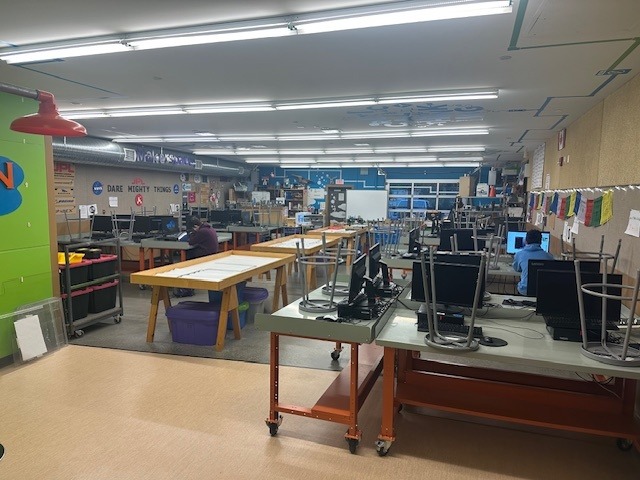
Blog Articles
What does it take to Make a MakerSpace?
December 4, 2024 — 3 minutes
Educator Spotlight: Dereck Dirom
To answer this question, we asked High School STEM Teacher Dereck Dirom from Abbotsford Sr Secondary School in British Columbia. Dereck has 25 years of teaching under his belt and about 16 years teaching STEM and Makerspace. What stands out about Dereck is the initiative he has taken to build a strong Makerspace program at his school and find creative ways to bring exciting technology to students in his community. Dereck’s Makerspace course enrolls students in grades 9-12 and teaches them to code electronics, iterate like an engineer, and engage in digital manufacturing. The Makerspace was given its initial start thanks to a grant from a local tech entrepreneur. Independent from the STEM “push” in the U.S., Dereck has had to do without top-down government initiatives in educational technology. “STEM is not in the everyday vernacular here because of different priorities,” he explains. “So I began an after-school program as an entrepreneur, which is called Gear Bots.” Gear Bots picks up where Dereck’s school course leaves off or might be limited. Gear Bots offers programs after school as well as during the Summer. Dereck has even applied for funding through his clubs and uses that gear in his regular courses – making the most of his resources for his students.

One of Dereck’s favorite resources has become DroneBlocks, which he loves because of its video-based trainers and scaffolding instructions that vary from basic to complex. Dereck finds DroneBlocks’ video courses allow students independence, and they fit the varying abilities of the students and their skill levels: “There is a very high percentage chance of success with video-based resources.” Dereck explains that he begins his 3rd year students on the DroneBlocks block coding unit and the Simulator, and then they upgrade to flying Tello EDUs in the classroom. “Once they are comfortable coding, then I get them into Open CV.” As Dereck allows his students to explore DroneBlocks courses at their own pace, tracing their progress is important. This led to the creation of a physical DroneBlocks checklist sheet that Dereck created with his students, which he was generous enough to share HERE. “I’ve been very happy with the courses because it’s giving a structure…in my program, if I have 30 kids, I can have 30 kids on different paths, which gets very busy and chaotic in a good way. Having resources where I can point them to step by step, with the assurance that they will complete it, is very helpful.”

Abbotsford Sr Secondary School has a large population of international students who visit. So, as an example, Dereck tells the story of two students from Germany who have prior experience in Python coding. “They’ve been going further than anticipated…they ate up the OpenCV Courses quickly and are now exploring their way through having their Tello EDU follow the path of a line drawn throughout the maker space.” DroneBlocks video resources have also been used to help ESL students understand concepts at their own pace to understand the language and develop coding skills and concepts.
It is DroneBlocks’ hope that other educators can appreciate and emulate Dereck’s efforts and experience in their own STEM spaces and that his DroneBlocks checklist will come in handy! DroneBlocks is also proud to continue supporting the Tello EDU and our Tello-focused course catalog as students continue to reap the benefits of the technology.
Shop More Products
From classroom-friendly kits to hands-on tools: Explore our hardware, packages, and accessories tailored for the educational journey.